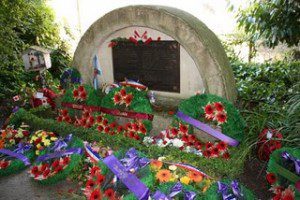The lunch seemed more elegant than it really was: jambon, fromage et tarte framboises. My dining partners, enjoying ham sandwiches with cheese and strawberry tarts, were fellow travellers – a retired public servant, a photographer and a D-Day veteran – in the Normandy region of France. Suddenly, however, the lunch became secondary, when a stranger approached us. She spotted our Canadian pins.
 “Do you know about the ceremony today at l’Abbaye d’Ardenne?” she asked.
“Do you know about the ceremony today at l’Abbaye d’Ardenne?” she asked.
We nodded. We told her our group of 47 Canadians – on a tour of Normandy for the 65th anniversary of the June 6, 1944, invasion – had included the ceremony she mentioned. We knew that on this day – D-Day-plus-1 – members of German commander Kurt Meyer’s 12th SS Panzer Division had captured and executed 20 Canadian soldiers and then hurriedly buried their bodies in the garden of the thousand-year-old Catholic chapel.
“It’s the most important thing in my life to remember the murdered Canadians,” she said on the verge of tears, “and to make sure the story doesn’t die.”
Her name is Joelle-Lise Perthuis. At 56, her lifetime occupation has been as a teacher of French, Latin and Greek at a Paris high school. But her more recent life’s preoccupation has been the murders at l’Abbaye. She described the shame she felt when she first came to the chapel near Caen, a decade ago, to find just a cultural centre and no acknowledgment of the SS atrocity (she called it “crime de guerre.”) She trembled with emotion, trying to articulate her anger both at the Hitler youth soldiers who shot the Canadian troops and equally the French government for ignoring the gruesome deaths.
“I come here every year without fail,” she said. “It’s impossible to forget these liberating Canadian soldiers.”
Just hours before this extraordinary encounter, D-Day veteran Don Kerr, HR retiree Neil Moodie, photographer Paul Alexander and the rest of our group had visited Juno Beach where the first wave of Queen’s Own Rifles of Canada assault troops had stormed Hitler’s Atlantic Wall near the famous tutor-styled house seen in all those D-Day pictures of Bérnieres-sur-Mer. By coincidence, while there, a Royal Navy veteran – visiting from Britain – approached us to meet the veterans in our tour group. We all noticed his chest was laden with medals.
“The French keep giving me these awards,” said 85-year-old Ted Emmings, “but the Canadians who landed here on D-Day deserve the credit … They suffered so much.”
The landing craft on which Emmings served, he said, delivered 36 Canadians to the beach in front of Bérnieres on D-Day. He couldn’t believe how many never made it to shore. He mentioned a Canadian sergeant with whom he’d spent 14 months training for the invasion, but “he didn’t get two yards up the beach before he was killed.”
Two days earlier, a Normandy-area dentist I know, took time from his busy schedule of attending patients, assisting the planning of D-Day anniversary observances, and chauffeuring veterans around, to speak to our tour group. In addition to the drama of the wider invasion story, Dr. Jean-Pierre Bénamou reminded us that Canadian troops had paid the highest price during the liberation of Normandy (between June and August 1944.) While the U.K. had suffered one casualty for each 30 men in its forces, and the U.S. one in 17, Canada had sustained one in five casualties.
“These young Canadian soldiers helped turn the tide on D-Day,” he emphasized.
Then, to our amazement and in the midst of his dissertation, the unassuming doctor answered a cellphone call. He began searching the nearly cloudless skies above us as he spoke into the phone. He nodded, turned to the east and pointed just above the horizon.
 “In a few minutes, an RAF Spitfire from Le Havre will arrive overhead,” Bénamou said. For us, we asked? He nodded and smiled. “A special aerobatic display for you Canadians in honour of your veterans and what your country did for France.”
“In a few minutes, an RAF Spitfire from Le Havre will arrive overhead,” Bénamou said. For us, we asked? He nodded and smiled. “A special aerobatic display for you Canadians in honour of your veterans and what your country did for France.”
The sleek, vintage fighter plane did not disappoint. It roared at low level over our heads, then climbed, rolled and dove past us again. The sighs of awe and delight from our tour group reminded me of those at the best of the CNE air shows or after the finale at a May 24 fireworks display.
“It was the stout-hearted Canadians,” Bénamou said, “boys just 18 and 20 years old … that won the day 65 years ago.”
Three separate encounters with three non-Canadians had given us more reason to be proud Canadians than many of us had been in years. It’s a pity we had to travel halfway ’round the globe to experience it.